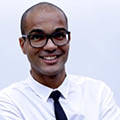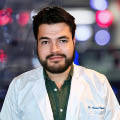Radiology is a field that demands continuous learning and skill enhancement. One of the most effective means to achieve this is by participating in the ACR Institute for Radiologic Pathology™ (AIRP®) course, a four-week intensive program comprehensively covering radiologic pathology.
The course is designed to boost radiologists’ diagnostic skills and patient care by linking radiologic findings with pathology. Residents and fellows worldwide can choose in-person and online attendance, but the advantages of in-person attendance are unique.
Doing it in person allows you to meet people from different places and learn about how radiology services work in various locations.
Three international residents who attended the AIRP program in person in September 2023 shared their views about the experience with the ACR Bulletin, focusing on their motivations, preparations and challenges, and the benefits of studying abroad.
Felipe Alves de Oliveira, MD, Brazil
Oliveira, a Brazilian radiologist with three years of experience, attended the AIRP course to gain a different approach to pathology. In Brazil, radiologists tend to emphasize imaging features over underlying pathology, and Oliveira sought to bridge this gap. He also aimed to learn from esteemed experts in the field and stay updated on the latest radiology advancements.
 “I was eager to enroll in this course to improve my diagnostic skills through a deeper understanding of pathology,” Oliveira says.
“I was eager to enroll in this course to improve my diagnostic skills through a deeper understanding of pathology,” Oliveira says.
To attend the course, Oliveira had to plan ahead and overcome some obstacles. He saved money for the course fee, travel expenses and accommodations. Additionally, he had to apply for a U.S. visa, which entailed paperwork and an embassy interview.
English proficiency was essential for comprehending lectures, engaging in discussions and communicating with peers and instructors. Oliveira found the language barrier to be his main challenge and occasionally used online translators or sought assistance from fellow participants and instructors.
Attending the course in person provided Oliveira with a unique opportunity to compare radiologic practices globally and gain insights from different perspectives. Meeting radiologists from diverse regions such as Europe, Asia, Africa and North America exposed him to varying challenges, solutions and innovations in radiology, broadening his career horizons. The course also exposed him to a variety of rare and complex cases, which stimulated his diagnostic skills and curiosity. Oliveira appreciated the feedback and guidance from the knowledgeable instructors.
For international residents considering in-person attendance, Oliveira advised being well-prepared, improving English skills and being open to new experiences and cultures. He firmly believes the effort and investment in attending the course in person were worthwhile, offering a unique learning opportunity and a memorable experience.
Manuel Sebastián Páez Álvarez, MD, Colombia/Spain
Páez, a radiology resident from Colombia currently training in Spain, attended the AIRP course as part of his residency program’s international rotation requirement. He chose this course based on positive reviews from colleagues and mentors who had previously attended. His goal was to enhance his radiology knowledge and network with peers and experts worldwide.
 Páez did not face significant cultural or professional adaptation issues in the U.S. He was already familiar with aspects of American culture and medicine because of previous travels and studies. His English proficiency was strong, as he had been studying the language since childhood and had taken several courses in Spain. This enabled him to comfortably communicate with others during the course.
Páez did not face significant cultural or professional adaptation issues in the U.S. He was already familiar with aspects of American culture and medicine because of previous travels and studies. His English proficiency was strong, as he had been studying the language since childhood and had taken several courses in Spain. This enabled him to comfortably communicate with others during the course.
“For most of us, it's not mandatory to take the course,” Páez says. “When you decide to do it, it’s about an opportunity to go over high-yield radiology topics from another perspective. It's a chance to get additional training during your residency. Doing it in person allows you to meet people from different places and learn about how radiology services work in various locations.”
He credits in-person attendance with significantly improving his understanding of radiopathology. Páez learned to correlate radiologic findings with pathology specimens, refining his differential diagnoses across organ systems. Additionally, he honed his ability to identify characteristic imaging features related to specific diseases or conditions, deepening his comprehension of clinical and treatment implications.
He prepared for the course by reviewing common radiology acronyms and abbreviations, such as CT, MRI and PET, and he collaborated with other participants on case presentations, which were part of the course requirements. He found working with others and sharing knowledge and opinions to be enjoyable and enriching.
Páez appreciated the course's well-structured format, pacing and accessibility to course materials online, allowing him to revisit lectures and cases at his convenience. He encouraged other international residents to attend the course in person because he believes it enhances diagnostic skills and patient care while offering valuable networking opportunities with peers and experts from diverse backgrounds and specialties.
Míriam Gállego Casals, Spain
Gállego, a radiology resident from Spain, attended the AIRP course based on positive reviews and recommendations from fellow residents. She had aspired to attend the course since the beginning of her residency because of its reputation as one of the best in radiology. She also chose the course for its comprehensive radiology overview and for English immersion, which is crucial for the European board exam.
 Gállego preferred in-person attendance over the online option, believing it offered a more immersive learning experience and helped her stay focused on the course content, avoiding distractions. Attending in person allowed her to interact face-to-face with instructors and fellow participants, giving her a chance to explore the beauty and history of Washington, D.C.
Gállego preferred in-person attendance over the online option, believing it offered a more immersive learning experience and helped her stay focused on the course content, avoiding distractions. Attending in person allowed her to interact face-to-face with instructors and fellow participants, giving her a chance to explore the beauty and history of Washington, D.C.
Adapting to a new environment and culture presented challenges for Gállego, including adjusting to the time difference, weather, food and transportation system. She also had to navigate cultural differences, such as social norms, etiquette and humor. Occasionally, she experienced feelings of homesickness and loneliness but mitigated them by staying in touch with family and friends.
One of the key benefits of attending the course in person, she says, was interacting with peers from various countries and regions, each with diverse backgrounds and specialties like pediatrics, neurology and oncology. These interactions enriched her knowledge and broadened her horizons.
Gállego prepared for the course by studying topics in advance, including anatomy, physiology and pathology. She also improved her English skills through reading articles, watching videos and listening to podcasts, ensuring she was well-prepared for both course content and effective communication.
“I chose this course because it’s a good opportunity to learn some words,” she says. “I’m used to studying in Spanish. We read a lot of articles in English, but it’s not the same. Here, it's like I have a summary of everything in English and it is well-organized.”
She lauded the course's organization and quality, finding that it exceeded her expectations. She described it as well-structured, well-paced, well-delivered, informative, comprehensive and up to date. The course significantly improved her radiology skills.
Gállego believes the cost of attending the course in person was reasonable, considering the benefits it offered. She considers it an investment in her career and a unique adventure in her life.
Overall, she expressed satisfaction with the course and her positive experience in Washington, saying attending in person was one of the best decisions she has ever made and one of her most memorable experiences.
Registration for the In-Person AIRP Program
The AIRP course provides valuable opportunities for international residents to expand their horizons, learn from experts and network with peers. It offers both online and in-person options, each with distinct advantages. The in-person option demands more preparation and investment but yields more benefits and experiences, while the online option offers greater convenience and flexibility but less interactivity. The choice ultimately depends on individual preferences, goals and circumstances.
For more information about the AIRP course or to register for an upcoming session, visit the AIRP website.

